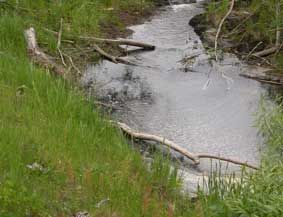Major Group: Insecta
Order: Diptera
Family: Stratiomyidae
Subfamily: Stratiomyinae
Genus: Odontomyia
Aquatic species of Stratiomyidae are represented by a single genus, Odontomyia. |
Descriptive Features: head capsule incomplete, reduced in size and structure, strongly sclerotized and non-retractile
maxillary palps and antenna distinguishable
mandibles usually with hooked apical tooth and lacking inner teeth
body flattened, hardened by accumulated calcarious deposition
abdomen 8-segmented
terminal fissure horizontal
posterior spiracles close together and lying concealed within terminal fissure of anal segment
Total length: up to 30mm |

|
Odontomyia |
|
|
|
Taxonomic Checklist: Species
Odontomyia amyris Walker
Odontomyia annulipes Macquart
Odontomyia carinata Macquart
Odontomyia carinifacies Macquart
Odontomyia decipiens Guérin-Méneville
Odontomyia grandimaculata Hardy
Odontomyia hunteri Macleay
Odontomyia ialemus Walker
Odontomyia kirchneri Jaennicke
Odontomyia lateremaculata Macquart
Odontomyia marginella Macquart
Odontomyia minima Hardy
Odontomyia opertanea White
Odontomyia pallida Hill
Odontomyia pectoralis Thomson
Odontomyia picea Walker
Odontomyia regisgeorgii Macquart
Odontomyia rufifacies Macquart
Odontomyia scutellata Macquart
Odontomyia sidneyensis Schiner
Odontomyia stricta Erichson
Odontomyia stylata Macquart
Odontomyia subdentata Macquart |
|
Distribution: Australia wide
Sensitivity Rating: SIGNAL grade 2
Functional Feeding Group: gathering collectors |

|
Watchingorra Creek nr Mitta Mitta, Vic |
|
|
Ecology: Stratiomyid adults are commonly known as ‘soldier flies’
Instream habitat: Stratiomyid larvae occur in shallow areas of ponds and stream backwaters where they live in the sediment or amongst macrophytes. Larvae can be found in both saline and freshwaters and are able to tolerate polluted water.
Feeding ecology: Larvae are gathering collectors feeding on decaying organic matter and micro-algae.
Habit: Larvae are poor swimmers and slowly crawl along the sediment or float in the water column.
Life history: Females lay up to 200 eggs in a group in the water. Larvae hatch after a couple of weeks and go through several larval instars before pupation. When the final instar is ready to pupate, the larva leaves the water but may not pupate for several days. Pupation occurs within the last larval skin and lasts for four weeks. Adults only live for a few days and it is possible that females mate on the day of emergence. Adults are usually present during spring or summer. There is one generation per year. |
| |
Information Sources: Colless & McAlpine 1991, Hawking & Smith 1997, Wade et al. 2004, Elliot 2005, Williams 1980, Gooderham & Tsyrlin 2002, Evenhuis 2007, Merritt & Cummins 1996
Key to Species: none |
|
|
|